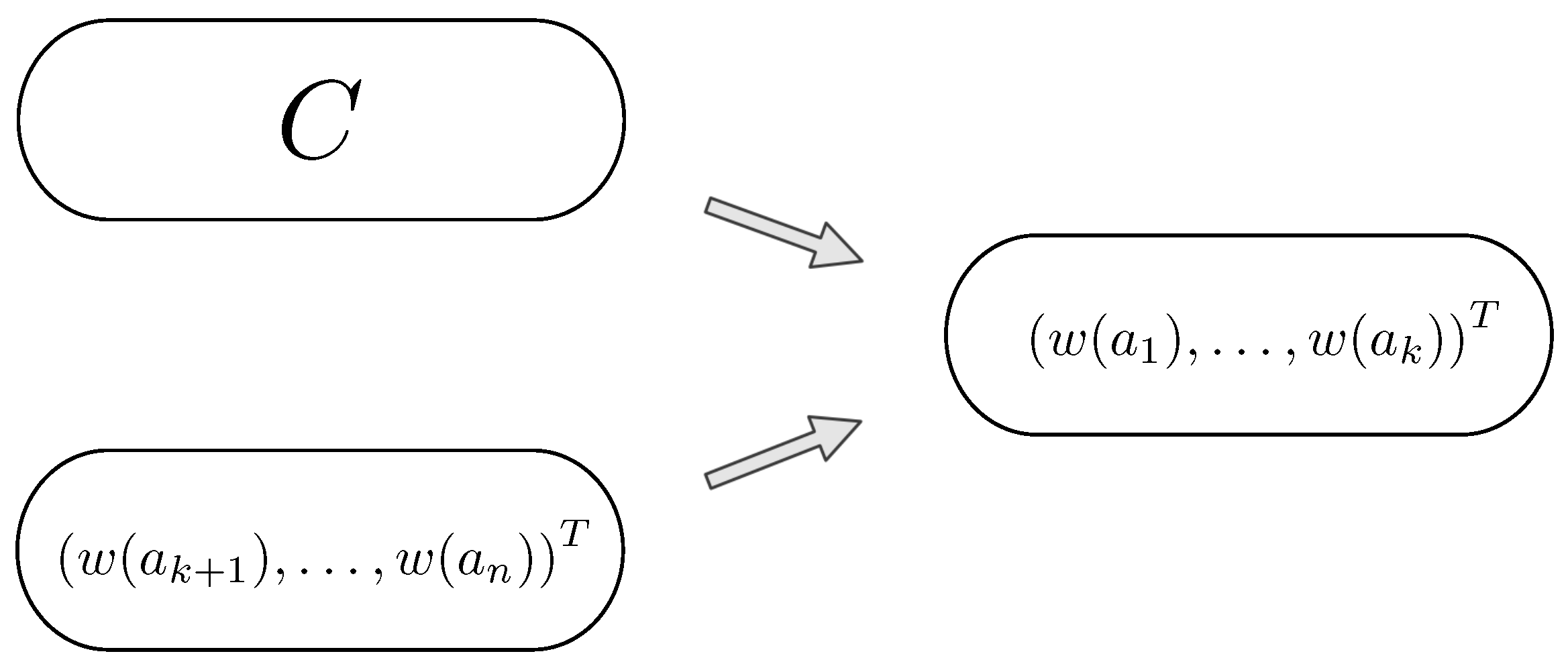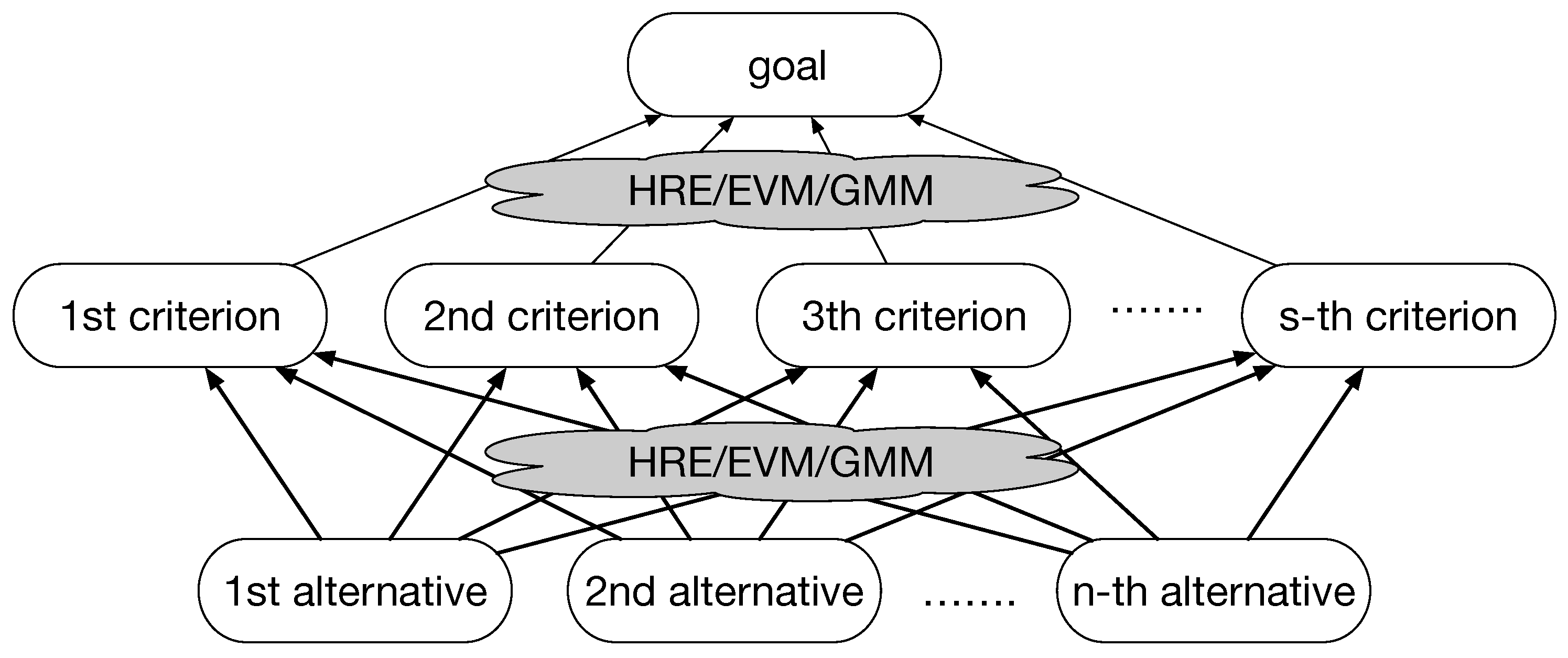Multiple-Criteria Heuristic Rating Estimation
Abstract
1. Introduction
2. Related Works
3. Preliminaries
3.1. Pairwise Comparisons
3.2. Analytic Hierarchy Process
4. Heuristic Rating Estimation
5. Multiple-Criteria Heuristic Rating Estimation Method
6. Numerical Examples
7. Discussion and Summary
Author Contributions
Funding
Data Availability Statement
Acknowledgments
Conflicts of Interest
References
- Vasconcelos, G.R.; Maria De Miranda Mota, C. Exploring Multicriteria Elicitation Model Based on Pairwise Comparisons: Building an Interactive Preference Adjustment Algorithm. Math. Probl. Eng. 2019, 2019, 2125740. [Google Scholar] [CrossRef]
- Harker, P.T.; Vargas, L.G. The Theory of Ratio Scale Estimation: Saaty’s Analytic Hierarchy Process. Manag. Sci. 1987, 33, 1383–1403. [Google Scholar] [CrossRef]
- Kułakowski, K. Heuristic Rating Estimation Approach to The Pairwise Comparisons Method. Fundam. Inform. 2014, 133, 367–386. [Google Scholar] [CrossRef]
- Kułakowski, K.; Grobler-Dębska, K.; Wąs, J. Heuristic rating estimation: Geometric approach. J. Glob. Optim. 2015, 62, 529–543. [Google Scholar] [CrossRef]
- Saaty, T.L. A scaling method for priorities in hierarchical structures. J. Math. Psychol. 1977, 15, 234–281. [Google Scholar] [CrossRef]
- Crawford, R.; Williams, C. A note on the analysis of subjective judgement matrices. J. Math. Psychol. 1985, 29, 387–405. [Google Scholar] [CrossRef]
- Kułakowski, K. Understanding the Analytic Hierarchy Process; Chapman and Hall/CRC Press: Boca Raton, FL, USA, 2020. [Google Scholar] [CrossRef]
- Colomer, J.M. Ramon Llull: From ‘Ars electionis’ to social choice theory. Soc. Choice Welf. 2011, 40, 317–328. [Google Scholar] [CrossRef]
- Hägele, G.; Pukelsheim, F. Llull’s writings on electoral systems. Stud. Lul. 2001, 41, 3–38. [Google Scholar]
- Condorcet, M. Essai sur L’application de L’analyse à la Probabilité des Décisions Rendues à la Pluralité des Voix; Imprimerie Royale: Paris, France, 1785. [Google Scholar]
- Dzhafarov, E.; Colonius, H. The Fechnerian idea. Am. J. Psychol. 2011, 124, 127–140. [Google Scholar] [CrossRef]
- Thurstone, L.L. A Law of Comparative Judgment, reprint of an original work published in 1927. Psychol. Rev. 1994, 101, 266–270. [Google Scholar] [CrossRef]
- Ramik, J. Pairwise Comparisons Method: Theory and Applications in Decision Making; Springer: Berlin/Heidelberg, Germany, 2020. [Google Scholar]
- Yuen, K.K.F. Combining compound linguistic ordinal scale and cognitive pairwise comparison in the rectified fuzzy TOPSIS method for group decision making. Fuzzy Optim. Decis. Mak. 2014, 13, 105–130. [Google Scholar] [CrossRef]
- Brans, J.; Mareschal, B. Promethee Methods. In Multiple Criteria Decision Analysis: State of the Art Surveys; Figueira, J., Greco, S., Ehrgott, M., Eds.; Springer: Boston, MA, USA; Dordrecht, The Netherlands; London, UK, 2016; pp. 187–219. [Google Scholar]
- Bana e Costa, C.; De Corte, J.M.; Vansnick, J. On the Mathematical Foundation of MACBETH. In Multiple Criteria Decision Analysis: State of the Art Surveys; Figueira, J., Greco, S., Ehrgott, M., Eds.; Springer: Boston, MA, USA; Dordrecht, The Netherlands; London, UK, 2016; pp. 421–463. [Google Scholar]
- Rezaei, J. Best-worst multi-criteria decision-making method. Omega 2015, 53, 49–57. [Google Scholar] [CrossRef]
- Kadziński, M.; Ciomek, K.; Słowiński, R. Modeling assignment-based pairwise comparisons within integrated framework for value-driven multiple criteria sorting. Eur. J. Oper. Res. 2015, 241, 830–841. [Google Scholar] [CrossRef]
- Saaty, T.L.; Vargas, L.G. Decision Making with the Analytic Network Process: Economic, Political, Social and Technological Applications with Benefits, Opportunities, Costs and Risks; Springer Science and Business Media: Boston, MA, USA, 2013; Volume 195. [Google Scholar]
- Lidinska, L.; Jablonsky, J. AHP model for performance evaluation of employees in a Czech management consulting company. Cent. Eur. J. Oper. Res. 2018, 26, 239–258. [Google Scholar] [CrossRef]
- Kramulová, J.; Jablonský, J. AHP model for competitiveness analysis of selected countries. Cent. Eur. J. Oper. Res. 2016, 24, 335–351. [Google Scholar] [CrossRef]
- Rezaei, J.; Ortt, R. Multi-criteria supplier segmentation using a fuzzy preference relations based AHP. Eur. J. Oper. Res. 2013, 225, 75–84. [Google Scholar] [CrossRef]
- Charouz, J.; Ramík, J. A multicriteria decision making at portfolio management. Ekon. Manag. 2010, 13, 44–52. [Google Scholar]
- Szabo, Z.K.; Szádoczki, Z.; Bozóki, S.; Stanciulescu, G.C.; Szabo, D. An analytic hierarchy process approach for prioritisation of strategic objectives of sustainable development. Sustainability 2021, 13, 2254. [Google Scholar] [CrossRef]
- Jamshidi, A.; Jamshidi, F.; Ait-Kadi, D.; Ramudhin, A. A review of priority criteria and decision-making methods applied in selection of sustainable city logistics initiatives and collaboration partners. Int. J. Prod. Res. 2019, 57, 5175–5193. [Google Scholar] [CrossRef]
- Lu, F.; Bi, H.; Feng, W.; Hu, Y.; Wang, S.; Zhang, X. A Two-Stage Auction Mechanism for 3PL Supplier Selection under Risk Aversion. Sustainability 2021, 13, 9745. [Google Scholar] [CrossRef]
- Lu, F.; Hu, Y.; Bi, H.; Huang, M.; Zhao, M. An Auction Approach for Cost and Schedule Management of IT Outsourcing Project. Asia-Pac. J. Oper. Res. 2018, 35, 1850034. [Google Scholar] [CrossRef]
- Al-Subhi Al-Harbi, K.M. Application of the AHP in project management. Int. J. Proj. Manag. 2001, 19, 19–27. [Google Scholar] [CrossRef]
- Hyde, R.A.; Davis, K., A. Military applications of the analytic hierarchy process. Int. J. Multicriteria Decis. Mak. 2012, 2, 267. [Google Scholar] [CrossRef]
- Kou, G.; Ergu, D.; Lin, C.S.; Chen, Y. Pairwise comparison matrix in multiple criteria decision making. Technol. Econ. Dev. Econ. 2016, 22, 738–765. [Google Scholar] [CrossRef]
- Ho, W.; Ma, X. The state-of-the-art integrations and applications of the analytic hierarchy process. Eur. J. Oper. Res. 2018, 267, 399–414. [Google Scholar] [CrossRef]
- Darko, A.; Chan, A.P.C.; Ameyaw, E.E.; Owusu, E.K.; Pärn, E.; Edwards, D.J. Review of application of analytic hierarchy process (AHP) in construction. Int. J. Constr. Manag. 2019, 19, 436–452. [Google Scholar] [CrossRef]
- Bana e Costa, C.A.; Vansnick, J. A critical analysis of the eigenvalue method used to derive priorities in AHP. Eur. J. Oper. Res. 2008, 187, 1422–1428. [Google Scholar] [CrossRef]
- Barzilai, J.; Golany, B. AHP rank reversal, normalization and aggregation rules. Inf. Syst. Oper. Res. 1994, 32, 57–64. [Google Scholar] [CrossRef]
- Dyer, J.S. Remarks on the analytic hierarchy process. Manag. Sci. 1990, 36, 249–258. [Google Scholar] [CrossRef]
- Simon, D.; Zhao, M.; Qin, S.; Li, Q.; Lu, F.; Shen, Z. The Likelihood Ranking Methods for Interval Type-2 Fuzzy Sets Considering Risk Preferences. Math. Probl. Eng. 2015, 2015, 680635. [Google Scholar] [CrossRef]
- Sun, F.; Lu, F.; Bi, H.; Yu, C. FAHP based evaluation of IT Outsourcing risk. In Proceedings of the Proceeding of the 11th World Congress on Intelligent Control and Automation, Shenyang, China, 29 June–4 July 2014; pp. 602–604. [Google Scholar] [CrossRef]
- Ramik, J.; Korviny, P. Inconsistency of pair-wise comparison matrix with fuzzy elements based on geometric mean. Fuzzy Sets Syst. 2010, 161, 1604–1613. [Google Scholar] [CrossRef]
- Faramondi, L.; Oliva, G.; Setola, R.; Bozóki, S. Robustness to rank reversal in pairwise comparison matrices based on uncertainty bounds. Eur. J. Oper. Res. 2023, 304, 676–688. [Google Scholar] [CrossRef]
- Duleba, S.; Çelikbilek, Y.; Moslem, S.; Esztergár-Kiss, D. Application of grey analytic hierarchy process to estimate mode choice alternatives: A case study from Budapest. Transp. Res. Interdiscip. Perspect. 2022, 13, 100560. [Google Scholar] [CrossRef]
- Hovanov, N.V.; Kolari, J.W.; Sokolov, M.V. Deriving weights from general pairwise comparison matrices. Math. Soc. Sci. 2008, 55, 205–220. [Google Scholar] [CrossRef]
- Ishizaka, A.; Lusti, M. How to derive priorities in AHP: A comparative study. Cent. Eur. J. Oper. Res. 2006, 14, 387–400. [Google Scholar] [CrossRef]
- Barzilai, J. Deriving weights from pairwise comparison matrices. J. Oper. Res. Soc. 1997, 48, 1226–1232. [Google Scholar] [CrossRef]
- Saaty, T.L. Decision-making with the AHP: Why is the principal eigenvector necessary. Eur. J. Oper. Res. 2003, 145, 85–91. [Google Scholar] [CrossRef]
- Koczkodaj, W.W. A new definition of consistency of pairwise comparisons. Math. Comput. Model. 1993, 18, 79–84. [Google Scholar] [CrossRef]
- Brunelli, M. A survey of inconsistency indices for pairwise comparisons. Int. J. Gen. Syst. 2018, 47, 751–771. [Google Scholar] [CrossRef]
- Miller, J.R. The Assessment of Worth: A Systematic Procedure and Its Experimental Validation. Ph.D. Thesis, Massachusetts Institute of Technology, Cambridge, MA, USA, 1966. [Google Scholar]
- Kułakowski, K. Notes on the existence of a solution in the pairwise comparisons method using the heuristic rating estimation approach. Ann. Math. Artif. Intell. 2016, 77, 105–121. [Google Scholar] [CrossRef]


| Symbol | Description |
|---|---|
| A | set of alternatives |
| set of alternatives with a priori known priorities (in HRE) | |
| set of alternatives with a priori unknown priorities (in HRE) | |
| i-th alternative | |
| C | pairwise comparisons matrix |
| comparison of the i-th and j-th alternatives | |
| weight (priority) of the i-th alternative | |
| w | vector of priority weights |
| Saaty’s consistency index | |
| Koczkodaj’s inconsistency index | |
| M | auxiliary matrix (in the additive HRE method) |
| b | constant terms vector (in the additive HRE method) |
| N | auxiliary matrix (in the geometric HRE method) |
| d | constant terms vector (in the geometric HRE method) |
| logarithmized priority vector (in the geometric HRE method) |
Disclaimer/Publisher’s Note: The statements, opinions and data contained in all publications are solely those of the individual author(s) and contributor(s) and not of MDPI and/or the editor(s). MDPI and/or the editor(s) disclaim responsibility for any injury to people or property resulting from any ideas, methods, instructions or products referred to in the content. |
© 2023 by the authors. Licensee MDPI, Basel, Switzerland. This article is an open access article distributed under the terms and conditions of the Creative Commons Attribution (CC BY) license (https://creativecommons.org/licenses/by/4.0/).
Share and Cite
Kędzior, A.; Kułakowski, K. Multiple-Criteria Heuristic Rating Estimation. Mathematics 2023, 11, 2806. https://doi.org/10.3390/math11132806
Kędzior A, Kułakowski K. Multiple-Criteria Heuristic Rating Estimation. Mathematics. 2023; 11(13):2806. https://doi.org/10.3390/math11132806
Chicago/Turabian StyleKędzior, Anna, and Konrad Kułakowski. 2023. "Multiple-Criteria Heuristic Rating Estimation" Mathematics 11, no. 13: 2806. https://doi.org/10.3390/math11132806
APA StyleKędzior, A., & Kułakowski, K. (2023). Multiple-Criteria Heuristic Rating Estimation. Mathematics, 11(13), 2806. https://doi.org/10.3390/math11132806







